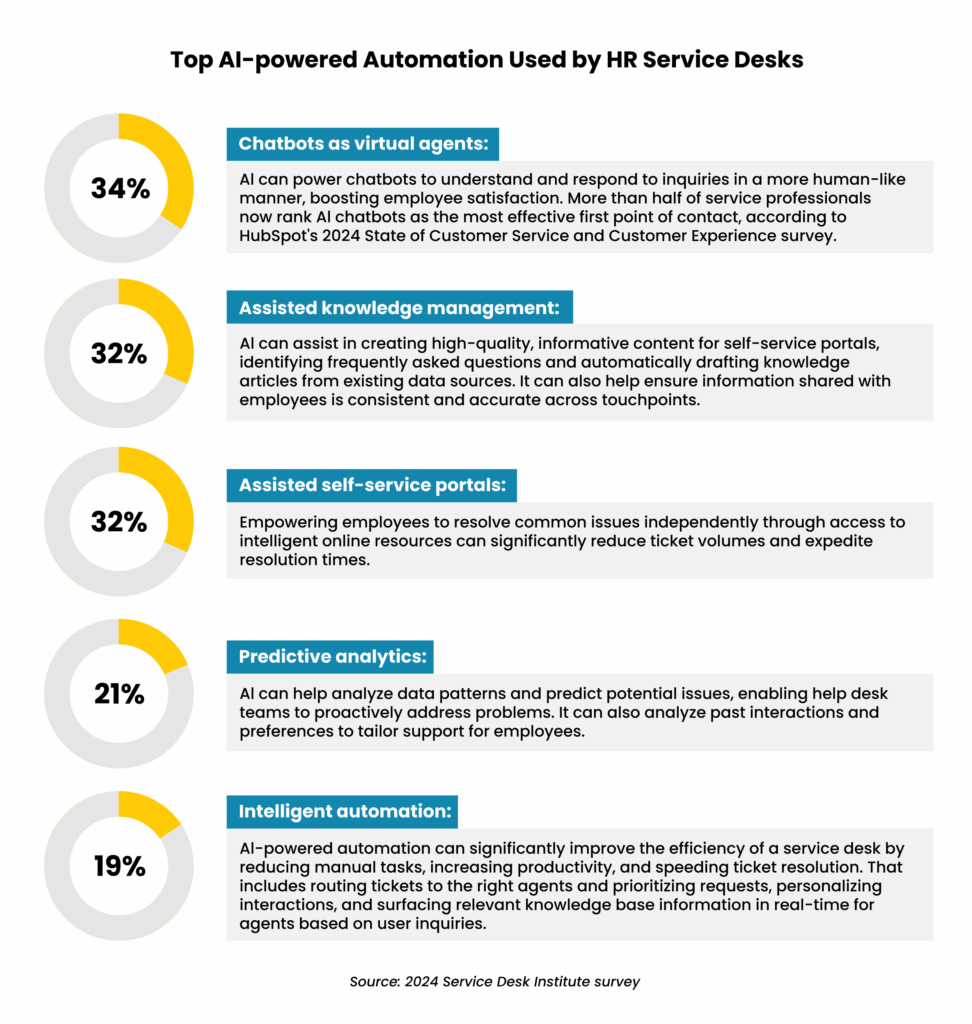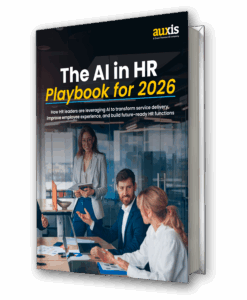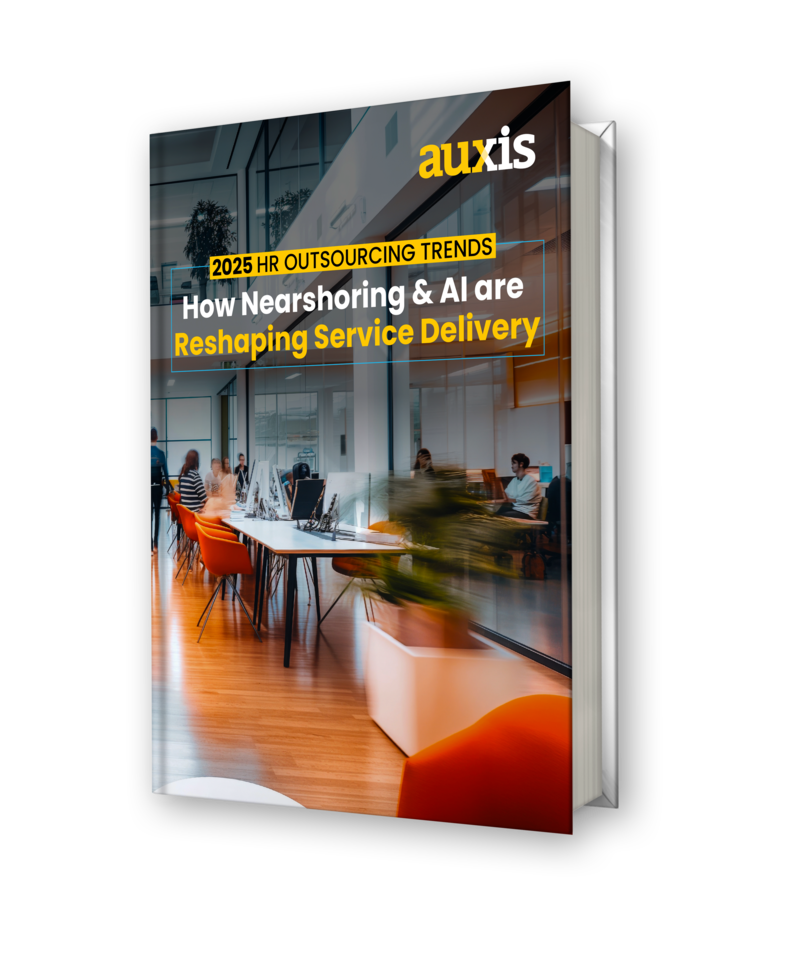In brief:
- HR departments are stretched thin, juggling rising service demands, disconnected systems, and limited resources.
- AI in HR examples include HR help desk automation, self-service portals, and onboarding workflows — with adoption jumping from 26% to 43% in a year (SHRM 2025).
- Agentic AI enables autonomous HR AI agents to orchestrate multi-step, cross-system workflows like payroll updates and onboarding sequences with minimal human input.
- AI success in HR depends on solid foundations, including small pilots, AI literacy, and embedded governance.
HR teams face fragmented systems and higher expectations from employees, driving slow responses, employee frustration, and retention risk. Artificial intelligence (AI) in HR changes that, adding context-aware, intelligent systems that make real-time decisions and power smarter help-desk routing, conversational self-service, tailored onboarding, and policy interpretation.
The payoff is more personalized support, earlier issue detection, and consistently responsive service.
Adoption of AI in HR has climbed to 40+% from 26% in 2024 (SHRM 2025), and nearly 90% of daily AI users report higher productivity (Betterworks 2025). However, 55% of HR leaders say their tech stack doesn’t meet evolving needs, and 76% fear they’ll fall behind without Generative AI adoption in the next 12–24 months (Gartner 2025).
Read on to discover the AI technologies, use cases, and strategies needed to build a future-ready HR function. For a deeper dive, don’t miss our new report, The AI in HR Playbook for 2026, which takes an in-depth look at how AI is transforming HR service delivery.
What AI in human resources tools should you consider?
AI for HR isn’t one-size-fits-all. Different types of AI support different goals such as automating repetitive tasks and making complex predictions.
Here are the key HR AI tools driving results:
- Agentic AI (AI Agents)
Agentic AI introduces autonomous HR agents that can plan, reason, and execute multi-step workflows across systems with minimal human input — for example, auto-syncing a name change across payroll, benefits, and tax records.
HR adoption of Agentic AI currently sits at 15% but is expected to spike to 64% within two years (Salesforce 2025 Agentic AI HR survey) — signaling a major shift in HR operations.
- Generative AI (GenAI)
GenAI is reshaping HR by drafting job descriptions, onboarding materials, training content, and performance summaries. It also powers chatbots that handle FAQs and supports strategic tasks like summarizing data for workforce planning. Yet only 23% of organizations have invested in HR-specific GenAI, leaving early adopters a major edge (Deloitte’s 2024 State of GenAI in Enterprise report).
- Machine Learning (ML)
Machine learning makes HR smarter, faster, and more personalized by learning from data and improving over time. It powers candidate-job matching, predictive analytics for attrition, staffing forecasts, performance trends, and compensation planning. ML also supports talent segmentation to improve recruitment and workforce planning.
- Intelligent Document Processing (IDP) & Intelligent Xtraction and Processing (IXP)
Alleviating one of the biggest pain points in an HR workflow, AI-powered IDP automates the extraction, classification, and processing of data from resumes, onboarding documents, employee records, payroll forms, compliance paperwork, and more — boosting efficiency and accuracy. IXP takes IDP to the next level with a next-gen ability to read, extract, and act on that data — orchestrating the whole downstream process automatically.
- Robotic Process Automation (RPA)
RPA automates repetitive, rules-based tasks like payroll, data entry, and compliance tracking — freeing HR to focus on higher-value work. When paired with AI, RPA acts as the “muscle” executing tasks while AI provides the “brain.” Together, they power end-to-end workflows, like pulling candidate data for GenAI to create personalized welcome emails.
5 examples of AI in HR driving real results
Here are use cases delivering real results across HR functions and the employee lifecycle:
Smarter employee self-service
AI is transforming HR self-service from static portals into intelligent assistants that understand context, interpret policies, and deliver real-time support. Employees can check PTO balances, update dependents, reset passwords, or get policy answers instantly, while complex issues are routed to human agents.
By resolving routine requests on the spot, AI self-service reduces ticket volumes, speeds response, and improves overall support quality — forming the foundation of a scalable HR model when paired with an AI-powered help desk.

HR help desk modernization
AI-powered help desks act as copilots for HR, classifying and routing requests, prioritizing tickets, and instantly surfacing policies or knowledge for human agents to enhance support. They can also summarize case histories, suggest responses, and flag trends that may signal systemic issues, thereby reducing wait times and quickening resolutions.
AI in back-office HR execution
Behind every HR service request lies a string of manual tasks — status updates, system entries, approvals, and more.
HR teams are strained: 92% of HR leaders cite lack of time and staff as their biggest barriers to achieving goals, and 76% say managers are overwhelmed by growing responsibilities.
SHRM & Gartner research
AI can automate these tasks through embedded features in platforms like SAP, Workday, and UKG, plus customized solutions that fill critical gaps. By orchestrating behind-the-scenes, cross-system workflows, AI boosts speed, accuracy, and compliance.
For example, Auxis leverages UiPath to design tailored automations beyond out-of-the-box capabilities.
Key HR AI tools use cases include:
- Status changes: Syncing promotions, transfers, and location updates across human capital management (HCM), payroll, and ID systems.
- Onboarding: Automating setup, background checks, and provisioning for faster, consistent starts.
- Payroll: Applying routine adjustments, flagging anomalies, and supporting tax compliance.
- Benefits: Guiding enrollment, validating inputs, and recommending personalized options.
- Compliance: Automating policy acknowledgement and contract updates.
- Process improvement: Analyzing ticket data to uncover bottlenecks and fuel continuous process improvement.
AI across the employee lifecycle
From talent acquisition to retention, AI is transforming every stage of the employee journey. These AI in HR examples highlight how forward-thinking teams can prepare for the future of AI in HR.
- Talent acquisition
AI can accelerate the hiring process with smart job descriptions, resume scanning, predictive analytics, and 24/7 candidate communication, helping teams hire faster and smarter.
- Employee transitions
From onboarding to offboarding, AI automates document collection, system access, policy updates, and exit steps — delivering a smoother experience for employees and HR alike.
- Learning and development
AI can personalize training, adapt content to learner progress, and identify high-potential talent, thereby closing skill gaps and supporting employee development.
- Performance management
AI aggregates feedback, tracks KPIs, and surfaces insights, turning reviews into continuous, data-driven performance enablement.
- Employee engagement and retention
AI analyzes sentiment, detects disengagement, and recommends targeted interventions, boosting employee morale and helping organizations keep top talent.
Workforce planning and predictive analytics
AI can elevate workforce planning with faster, more accurate forecasting and scenario modeling. Predictive analytics leverage HR trends to anticipate staffing needs, identify at-risk employees, and flag skill gaps to guide hiring or upskilling. Narrative dashboards can then turn insights into action, while AI-powered career pathing connects employees with growth opportunities aligned to business goals.
What are the challenges of AI in HR?
While AI holds significant promise for transforming HR, there are some challenges to overcome. Engagedly’s 2024 AI in HR report found 17% of organizations have no plans to use AI in HR, citing concerns about privacy, bias, integration, and governance.
Here are the key challenges to consider as you plan your AI journey:
1. Employee data protection
HR teams manage sensitive data. Weak AI security in payroll, recruiting, or case management systems risks breaches, fines, and employee mistrust.
2. Bias in hiring and promotions
If AI learns from skewed data, it can amplify bias in résumé screening or performance models. Lifewire reports that 44% of recruiters worry AI may be more biased than traditional selection methods. Regular audits are, therefore, important.
3. AI literacy gaps
Only 30% of HR employees report receiving proper AI training. Yet, without AI literacy, teams may misuse tools like turnover analytics or underutilize investments, undermining outcomes.
4. System integration issues
AI tools must connect seamlessly with HR systems like Workday, SAP, or UKG. Poor integration risks siloed data, duplicate records, and compliance headaches.
5. Balancing automation with empathy
AI can’t replace human touch in career discussions, grievances, or exits. Over-automation risks eroding trust and morale.
6. Cost and adoption barriers
Smaller teams often lack the budget required for implementing advanced AI, while resistance to change in some organizations can stall adoption despite long-term benefits.
Best practices for implementing AI in HR
Successfully navigating AI in HR requires a structured, people-first approach grounded in clear goals, responsible governance, and thoughtful execution.
Gartner projects 60% of enterprises will have adopted a responsible AI framework in HR by the end of 2025, boosting trust and employee experience.
These best practices can help you unlock the full benefits of AI in HR:
1. Start small and scale with discipline
Launch pilots in low-complexity, high-impact areas like status updates, FAQs, or document routing. Then, define KPIs, measure user experience, and use insights to refine and expand adoption strategically.
2. Invest in AI literacy
Equip HR teams with role-based training, hands-on practice, and just-in-time learning so they can query tools, interpret results, and apply insights with confidence.
3. Embed governance from day one
While 60% of business leaders say they lack a clear AI vision, governance is critical. Formal HR committees and guardrails on bias, privacy, and ethics ensure safe, scalable adoption in sensitive areas like hiring and reviews.
4. Lay the groundwork with clean data and optimized processes
AI’s impact depends on data quality. Audit HR systems for accuracy, standardize formats, and streamline inefficient workflows before layering on automation.
5. Empower frontline innovation
Give HR staff tools and autonomy to propose and test automation ideas. This bottom-up approach fuels adoption and builds enthusiasm across teams.
6. Measure both qualitative and quantitative impact
Track ROI alongside softer wins such as lower burnout, faster service, and enhanced employee experience, which are often the biggest drivers of lasting HR transformation.
7. Pilot thoughtfully and scale with discipline
Define success early with clear KPIs and user feedback loops. Use those insights to refine execution and scale responsibly, balancing speed with governance, quality, and a strategic roadmap that drives long-term adoption.
Get the full AI in HR Playbook for 2026 report
HR leaders are under mounting pressure to deliver faster, smarter, and more employee-centric support. In 2026, AI is an important lever forward, reshaping back-office operations and transforming the employee experience across the entire lifecycle.
Download our 2026 Roadmap to AI in HR report for an in-depth look at the technologies, use cases, and strategies you need to modernize HR with confidence.
You will discover:
- Which HR AI tools are delivering real results in 2026
- Practical use cases for AI in HR across self-service portals, HR help desk, back-office execution, and more
- How Agentic AI and GenAI are redefining HR service delivery
- Common adoption challenges (data privacy, bias, skills gaps, etc.)
- Best practices to scale AI responsibly while preserving the human touch
- Why tech-enabled nearshoring is the fastest path to HR AI success in 2026
With nearly three decades of operational transformation expertise and recognition as a UiPath Partner of the Year and Agentic Automation Fast Track Partner, Auxis helps organizations modernize HR at speed and scale. Whether you’re piloting your first AI use case or reimagining HR through a tech-enabled shared services model, Auxis provides the strategy, technology, and nearshore delivery framework to turn AI potential into real HR impact.
Ready to turn AI potential into HR impact? Schedule a consultation with our HR experts or visit our resource center to learn more about HR trends, strategies, and outsourcing success stories.
Frequently Asked Questions
What is AI in HR?
What are the benefits of AI in HR?
How is AI used in HR?
Is AI taking over HR jobs?
Why is combining nearshoring and AI the most efficient model for HR operations?




